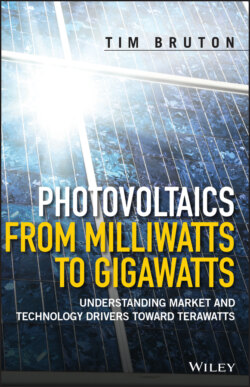Читать книгу Photovoltaics from Milliwatts to Gigawatts - Tim Bruton - Страница 22
1.4.1 Single‐Junction GaAs Solar Cells
ОглавлениеGaAs has a history almost as long as that of silicon. One of the first GaAs solar cells was made at RCA Laboratories in 1956, with an efficiency of 6% on very small‐area solar cells [66]. From that point on, significant progress was made, driven by the expectation of higher efficiency and enhanced radiation hardness. By 1981, the 20%‐efficiency barrier had been breached, with an n+/p/p+ GaAs structure on both germanium and GaAs substrates [67]. Early GaAs cells were made by liquid‐phase epitaxy, which had limits in terms of the alloys that could be produced, while the 1981 work was performed using vapour‐phase epitaxy. By the late 1990s, however, metal organic chemical vapour deposition (MOCVD) had become a well‐established technique for producing a wide range of III–V compounds [64]. In 1990, cells of over 25% efficiency were demonstrated using MOCVD for the epitaxial layers – in some cases, as thin as 0.1 μm [68]. The best cell had an efficiency of 25.7% under the AM1.5 Global spectrum; its structure is illustrated in Figure 1.13. The improved efficiency was derived in part from the use of a GaInP2 window at front and rear, such that the active carrier collection region was separated from the high recombination surfaces at the front and rear of the active GaAs cell.
Figure 1.12 Bandgap and lattice constant for the important III–V alloys [62]
(Courtesy Royal Society of Chemistry) Source: H. Cotal et al: Energy and Environmental Science 2 (2009) 174‐192
Figure 1.13 Structure of a 25.7% GaAs solar cell under the AM1.5 Global spectrum [68]
(Courtesy IEEE) Source: S.R. Kurtz, J.M. Olsen and A. Kibbler: Proc 21st IEEE PVSC (1990) 138‐140
GaInP2 was used in preference to the GaAlAs2 previously employed, as this was prone to degradation by the inclusion of oxygen. The work highlighted that the electronic quality of the individual layers was as important as the overall device structure in achieving very high efficiencies. Development of single‐junction GaAs has been relatively slow, as more research has gone into the higher‐efficiency potential triple‐junction cells. In 2008, the record efficiency was 26.1% [69]; in 2018, Alta Devices reported a new record for single‐junction GaAs cells of 28.9% [70], in the form of an ultrathin cell. This was intended not for space applications but for terrestrial ones, where very high efficiency is important (e.g. the Internet of Things, unmanned aircraft).
